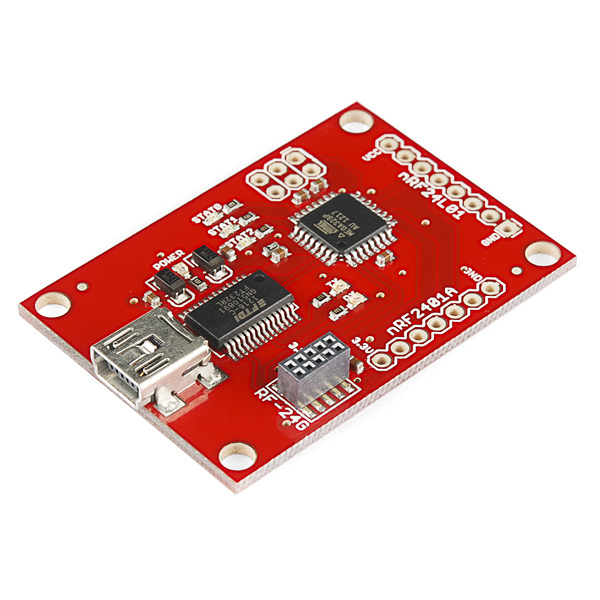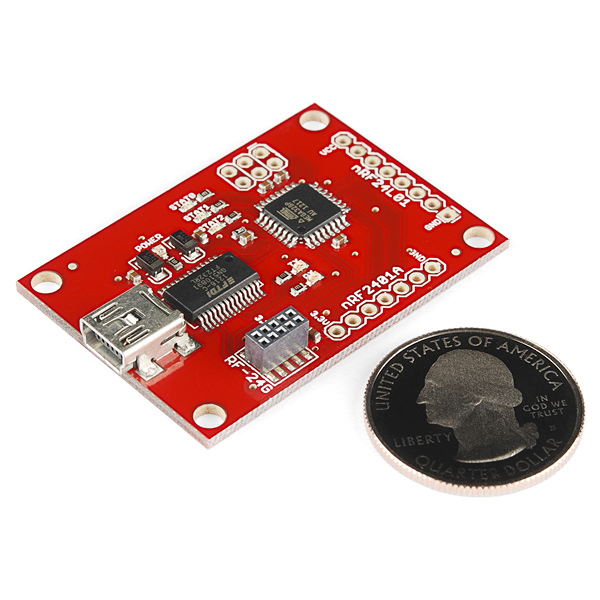×
SparkFun will be closed on Tuesday, December 24th, and Wednesday, December 25th, in observance of the Christmas holiday. Any orders qualifying for same day shipping placed after 2:00 p.m. (MST) on Monday, December 23rd, will be processed on Thursday, December 26th, when we return to regular business hours. Wishing you a safe and happy holiday from all of us at SparkFun!
Please note - we will not be available for Local Pick up orders from December 24th-December 27th. If you place an order for Local Pick-Up we will have those ready on Monday, December 30th.
Nordic Serial Interface Board
This is a simple serial to USB board that works with the nRF24L01, nRF2401A, and RF-24G Nordic transceivers. Comes with an ATMEGA328 preloaded with code that allows the transceivers to act as pass through serial devices (sends 4 characters at a time). When powered up, the board will determine which Nordic device has been attached (STAT0 will blink for an nRF24L01, or it will default to an nRF2401A and STAT1 will blink) and run the appropriate code. The LEDs then blink sequentially upon receiving packets over the RF link.
You will need to use VCP FTDI drivers, so that your USB connection comes up as a COM port. Then all you need to do is use a terminal program to communicate with the Nordic transceivers. This revision fixes the silkscreen error in the previous version.
Replaces:WRL-09019
Nordic Serial Interface Board Product Help and Resources
Core Skill: Soldering
This skill defines how difficult the soldering is on a particular product. It might be a couple simple solder joints, or require special reflow tools.
Skill Level: Noob - Some basic soldering is required, but it is limited to a just a few pins, basic through-hole soldering, and couple (if any) polarized components. A basic soldering iron is all you should need.
See all skill levels
Core Skill: Programming
If a board needs code or communicates somehow, you're going to need to know how to program or interface with it. The programming skill is all about communication and code.
Skill Level: Rookie - You will need a better fundamental understand of what code is, and how it works. You will be using beginner-level software and development tools like Arduino. You will be dealing directly with code, but numerous examples and libraries are available. Sensors or shields will communicate with serial or TTL.
See all skill levels
Core Skill: Electrical Prototyping
If it requires power, you need to know how much, what all the pins do, and how to hook it up. You may need to reference datasheets, schematics, and know the ins and outs of electronics.
Skill Level: Rookie - You may be required to know a bit more about the component, such as orientation, or how to hook it up, in addition to power requirements. You will need to understand polarized components.
See all skill levels
Comments
Looking for answers to technical questions?
We welcome your comments and suggestions below. However, if you are looking for solutions to technical questions please see our Technical Assistance page.
Customer Reviews
No reviews yet.





What are the fuse settings?
which compiler I can use?…
Can someone explain the purpose of cap C4 between RST and *DTR of the FT232?
What's the difference between this one and WRL-09019 ? Also, thought this may help some peeps. Tutorial 0: Everything You Need to Know about the nRF24L01 and MiRF-v2
This board is an improved version of WRL-09019. It looks the new version just uses a better microcontroller: the ATmega328 as opposed to the ATmega168V on the old board.